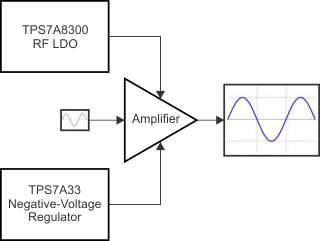ZHCSBA4E May 2013 – August 2014 TPS7A8300
PRODUCTION DATA.
- 1 特性
- 2 应用范围
- 3 说明
- 4 修订历史记录
- 5 Pin Configurations and Functions
- 6 Specifications
-
7 Detailed Description
- 7.1 Overview
- 7.2 Functional Block Diagram
- 7.3
Feature Description
- 7.3.1 ANY-OUT Programmable Output Voltage
- 7.3.2 Adjustable Operation
- 7.3.3 ANY-OUT Operation
- 7.3.4 2-A LDO with an Internal Charge Pump
- 7.3.5 Low-Noise, 0.8-V Reference
- 7.3.6 Internal Protection Circuitry
- 7.3.7 Programmable Soft-Start
- 7.3.8 Power-Good Function
- 7.3.9 Integrated Resistance Network (ANY-OUT)
- 7.4 Device Functional Modes
- 8 Application and Implementation
- 9 Power-Supply Recommendations
- 10Layout
- 11器件和文档支持
- 12机械封装和可订购信息
1 特性
2 应用范围
- 射频 (RF),IF 组件:压控振荡器 (VCO),数模转换器 (ADC),模数转换器 (DAC),低压差分信令 (LVDS)
- 无线基础设施:串化解串器 (SerDes),现场可编程栅极阵列 (FPGA), DSP™
- 测试和测量
- 仪器仪表、医疗和音频

3 说明
TPS7A8300 是一款低噪声 (6µVRMS),低压降 (LDO) 稳压器,能够在压降最大值只有 125mV 的情况下提供一个 2A 负载。
用户完全可以通过印刷电路板 (PCB) 布局布线来调节 TPS7A8300 输出电压,而无需外部电阻器,从而减少元件总数量。 对于更高输出电压应用,此器件在使用外部电阻器的情况下可实现高达 5V 的输出电压。 借助于一个额外的偏置电压轨,此器件支持极低输出电压(低至 1.1V)。
借助于极高精度(线路、负载和温度范围内达到 1%),遥感和可以减少涌入电流的软启动功能,TPS7A8300 非常适合为诸如高端微处理器和现场可编程门阵列 (FPGA) 等高电流、低电压的器件供电。
TPS7A8300 针对高速通信应用中的加电噪声敏感组件而设计。 极低噪声,6-µVRMS器件输出和高宽带电源抑制比 (PSRR)(1MHz 时为
40dB)大大减少了高频信号中的相位噪声和时钟抖动。 这些特性大大增加了计时器件、模数转换器 (ADC) 和数模转换器 (DAC) 的性能。
对于需要正向和负向低噪声电源轨的应用,请考虑 TI 的TPS7A33负向高电压、超低噪声线性稳压器系列产品。
器件信息(1)
| 部件号 | 封装 | 封装尺寸(标称值) |
|---|---|---|
| TPS7A8300 | 超薄四方扁平无引线封装 (VQFN) (20) | 5.00mm x 5.00mm |
| 超薄四方扁平无引线封装 (VQFN) (20) | 3.50mm x 3.50mm |
- 如需了解所有可用封装,请见数据表末尾的可订购产品附录。
4 修订历史记录
Changes from D Revision (February 2013) to E Revision
- 更改了格式以满足最新数据表标准;添加了新的部分并移动了现有部分Go
- 更改了第五个特性要点下的第一个分项 ANY-OUTGo
- 更改了第八个特性要点:将软启动输出和 PG 输出拆成了两个单独的特性要点Go
- 更改了说明部分中第二段的第一句。Go
- Changed RGW and RGR drawings: removed spacing between number and unit in pins 5 to 7 and 9 to 11 Go
- Changed first row of Pin Functions table: deleted spacing between number and unit in pin namesGo
- Added capacitor value to BIAS pin description in Pin Functions tableGo
- Changed 87% to 89% in the PG pin description of the Pin Functions tableGo
- Changed thermal pad description in Pin Functions tableGo
- Changed conditions statements for Absolute Maximum Ratings and Recommended Operating Conditions tables Go
- Added Recommended Operating Conditions tableGo
- Changed the Typical Characteristics section: changed all curve titles and conditions Go
- Changed title of Figure 11Go
- Added Overview section Go
- Changed second paragraph of Overview section: changed that can be groups, as follows to includingGo
- Changed functional block diagram footnoteGo
- Added Feature Description sectionGo
- Changed adjustable version to adjustable configuration in first paragraph of Adjustable Operation section Go
- Changed Figure 51: removed right-hand side diagramGo
- Added Figure 52Go
- Changed second sentence in Internal Charge Pump section Go
- Changed last sentence of UVLO sectionGo
- Changed oscillates to cycles in first paragraph of Thermal Protection sectionGo
- Changed first sentence of Programmable Soft-Start sectionGo
- Added Device Functional Modes sectionGo
- Added Application Information section Go
- Changed second paragraph of Noise sectionGo
- Added Typical Application section Go
- Added Figure 57Go
Changes from C Revision (July 2013) to D Revision
- Changed 将文档状态从混合状态更改为生产数据Go
- Deleted 删除了最后一个特性要点中第二个分项的脚注Go
- Deleted footnote from RGR package drawingGo
- Changed GND pin description in Pin Descriptions tableGo
Changes from B Revision (July 2013) to C Revision
- Deleted PG Functionality sectionGo
- Changed Power-Good sectionGo
- Changed text in Feed-Forward Capacitor subsectionGo
Changes from A Revision (June 2013) to B Revision
- 从产品预览更改为生产数据(混合状态)Go
Changes from * Revision (May 2013) to A Revision
- 更改了产品预览数据表Go